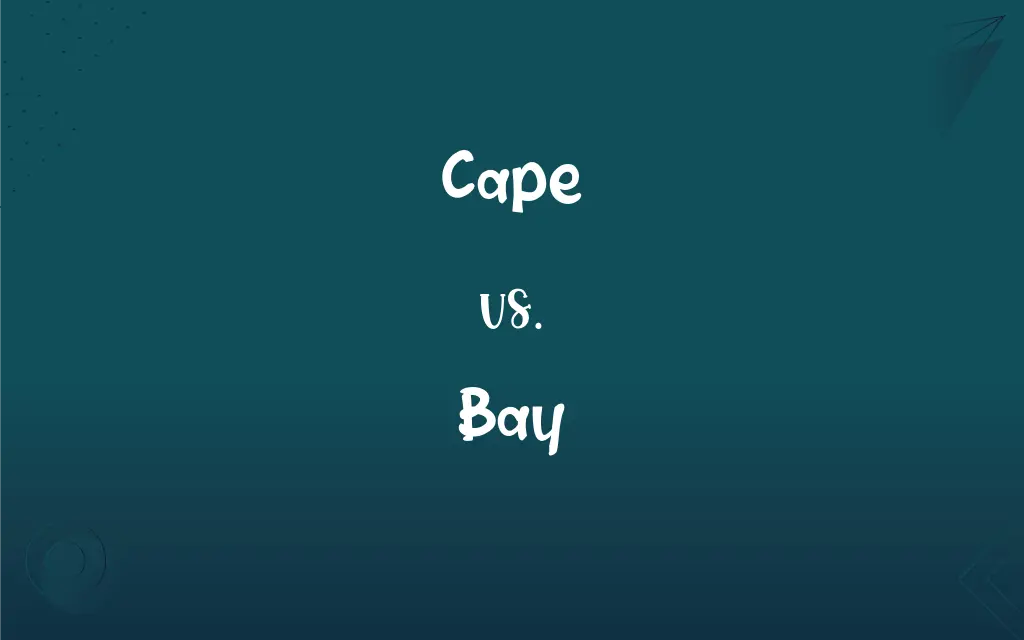Cape vs. Bay: What's the Difference?
By Janet White || Updated on March 3, 2024
A cape is a pointed landmass extending into a water body, providing a marked change in coastline direction, whereas a bay is a water body enclosed by land, typically on three sides, offering shelter to coastlines and harbors.

Key Differences
A cape is a prominent land feature that juts out into a sea or ocean, creating a distinct point on the coastline. These landforms are often marked by a significant change in the direction of the coastline and can provide navigational landmarks for sailors. On the other hand, a bay is a body of water that is partially enclosed by land, usually with a wider opening to the sea or ocean. Bays can vary greatly in size and shape, but they are typically sheltered areas compared to the open sea, making them important for fishing, shipping, and recreational activities.
Capes are usually formed by various geological processes, including the action of waves and currents which erode the land and shape the coastline. This can result in dramatic coastal features with cliffs and rugged terrain. Whereas bays are often the result of tectonic movements, such as the sinking of land or the flooding of coastal areas, leading to a recessed and sheltered water body.
The navigational significance of capes has been recognized for centuries, as they often mark critical points on shipping routes. Mariners use capes to navigate and to mark their progress along a coast. In contrast, bays have historically been valued as safe harbors and sites for settlements due to their protective waters. The calm waters of bays make them ideal locations for ports and cities.
Erosion plays a key role in shaping capes, with wind, water, and ice wearing away the land over time to create these distinctive points. On the other side, sediment deposition can significantly influence the formation and evolution of bays, with rivers and streams carrying sediments that accumulate and alter the bay's shape and depth.
Capes and bays both contribute to the biodiversity of their regions by providing unique habitats. Capes can create diverse ecological niches due to their exposure to varying weather and sea conditions. Meanwhile, bays often support rich marine ecosystems, with their sheltered waters fostering a variety of marine life, from fish to coral reefs.
ADVERTISEMENT
Comparison Chart
Definition
Pointed landmass extending into water
Water body partially enclosed by land
Formation
Erosion and geological processes
Tectonic movements, flooding
Navigational Use
Landmarks for sailors
Safe harbors for ships
Geological Features
Often rugged, with cliffs and headlands
Sheltered, with varying depths and shores
Ecological Impact
Diverse habitats due to exposure
Rich marine ecosystems in sheltered waters
ADVERTISEMENT
Cape and Bay Definitions
Cape
A cape is a pointed piece of land that sticks out into a sea, ocean, or lake.
Cape Cod is a popular vacation spot known for its beaches and maritime activities.
Bay
Bays often support rich marine and coastal ecosystems due to their sheltered waters.
Monterey Bay is renowned for its diverse marine life, including kelp forests and sea otters.
Cape
Capes can be sites of dramatic natural beauty, attracting tourists and nature enthusiasts.
The scenic views from Cape Hatteras Lighthouse draw visitors from around the world.
Bay
Sediment deposition plays a significant role in the formation and evolution of bays.
The Bay of Bengal is continually shaped by the sediments delivered by the Ganges and Brahmaputra rivers.
Cape
Capes often serve as significant maritime landmarks.
Sailors recognized Cape Horn as a crucial point in navigating around South America.
Bay
A bay is a broad inlet of the sea where the land curves inward.
San Francisco Bay is known for its iconic Golden Gate Bridge.
Cape
The ecological environments around capes can be diverse due to their exposure to various elements.
Cape Flattery is home to a wide range of wildlife, from seabirds to marine mammals.
Bay
The calm waters of bays make them ideal for recreational activities like boating and swimming.
Chesapeake Bay offers numerous spots for water sports and leisure.
Cape
The formation of capes is influenced by geological and erosional processes.
The rugged cliffs of Cape Point were shaped by the powerful forces of wind and water.
Bay
Bays serve as protected harbors and centers for fishing and commerce.
Tokyo Bay has been central to Japan's maritime activities for centuries.
Cape
A sleeveless outer garment fastened at the throat and worn hanging over the shoulders.
Bay
A body of water partially enclosed by land but with a wide mouth, affording access to the sea
The Bay of Biscay.
Cape
A brightly colored cloth used in maneuvering the bull in a bullfight; a capote or muleta.
Bay
An area of land, such as an arm of prairie partially enclosed by woodland, that resembles in shape or formation a partially enclosed body of water.
Cape
A point or head of land projecting into a body of water.
Bay
(Architecture) A part of a building marked off by vertical elements, such as columns or pilasters
An arcade divided into ten bays.
Bay
A bay window.
FAQs
Can a bay be part of a larger body of water?
Yes, a bay can be part of a larger body of water, such as a sea or ocean, and it is usually defined by its partial enclosure by land.
Are all capes rocky and elevated?
While many capes are rocky and elevated, not all fit this description. Some capes can be low-lying and sandy, depending on the local geology and erosional processes.
Can the shape of a cape or bay change over time?
Yes, the shape of capes and bays can change over time due to natural processes like erosion, sediment deposition, and tectonic activity.
What defines a cape in geography?
A cape is defined as a high point of land that extends into a river, lake, or ocean, often marked by a significant change in coastline direction.
How do human activities impact capes and bays?
Human activities, such as development, pollution, and overfishing, can significantly impact the ecosystems of capes and bays, affecting their natural features and biodiversity.
How do bays form?
Bays can form through various processes, including tectonic movements, sea-level rise, and the erosion of surrounding land, creating a recessed area filled with water.
Is a cape always surrounded by water on three sides?
No, a cape is typically pointed and extends into a body of water but is not necessarily surrounded by water on three sides, which is more characteristic of a peninsula.
Can a bay become a lake?
A bay can become a lake if it becomes entirely cut off from the larger body of water, typically due to geological changes or sediment deposition.
What is the difference between a bay and a gulf?
The main difference between a bay and a gulf is size and enclosure; gulfs are typically larger and more deeply indented than bays.
What is the largest bay in the world?
The Bay of Bengal is often considered the largest bay in the world, covering an area of approximately 2,172,000 square kilometers.
How does human development affect the natural state of bays?
Human development, including urbanization, industrialization, and the construction of maritime infrastructure, can alter the natural state of bays, impacting water quality, sediment flows, and habitats.
Are capes and bays important for navigation?
Yes, both capes and bays are important for navigation; capes serve as landmarks, while bays offer safe harbors and anchorage.
Do capes and bays have economic significance?
Yes, capes and bays often have economic significance due to their roles in shipping, fishing, tourism, and as sites for ports and settlements.
How do capes affect coastal erosion?
Capes can both contribute to and suffer from coastal erosion; their protruding nature makes them vulnerable to wave action, but they can also deflect currents and waves, protecting nearby coastlines.
What is the ecological impact of capes on bird migration?
Capes can serve as critical landmarks and resting points for migratory birds, offering refuge and feeding opportunities during long migrations.
What role do capes play in weather patterns?
Capes can influence local weather patterns by altering wind and ocean currents, often leading to unique microclimates around these landforms.
Are all bays safe harbors for ships?
While many bays provide safe harbors, not all are suitable for anchorage or protection from storms, depending on their size, depth, and exposure to prevailing winds and currents.
What conservation efforts are in place for capes and bays?
Conservation efforts for capes and bays may include protected area designation, habitat restoration projects, pollution control measures, and sustainable management practices to preserve their ecological and economic values.
Why are bays important for marine biodiversity?
Bays are crucial for marine biodiversity because their sheltered waters support a wide range of habitats, from seagrass beds to coral reefs, fostering a rich diversity of marine life.
How are capes named?
Capes are often named after geographical features, early explorers, prominent individuals, or local flora and fauna, reflecting their historical or natural significance.
About Author
Written by
Janet WhiteJanet White has been an esteemed writer and blogger for Difference Wiki. Holding a Master's degree in Science and Medical Journalism from the prestigious Boston University, she has consistently demonstrated her expertise and passion for her field. When she's not immersed in her work, Janet relishes her time exercising, delving into a good book, and cherishing moments with friends and family.































































